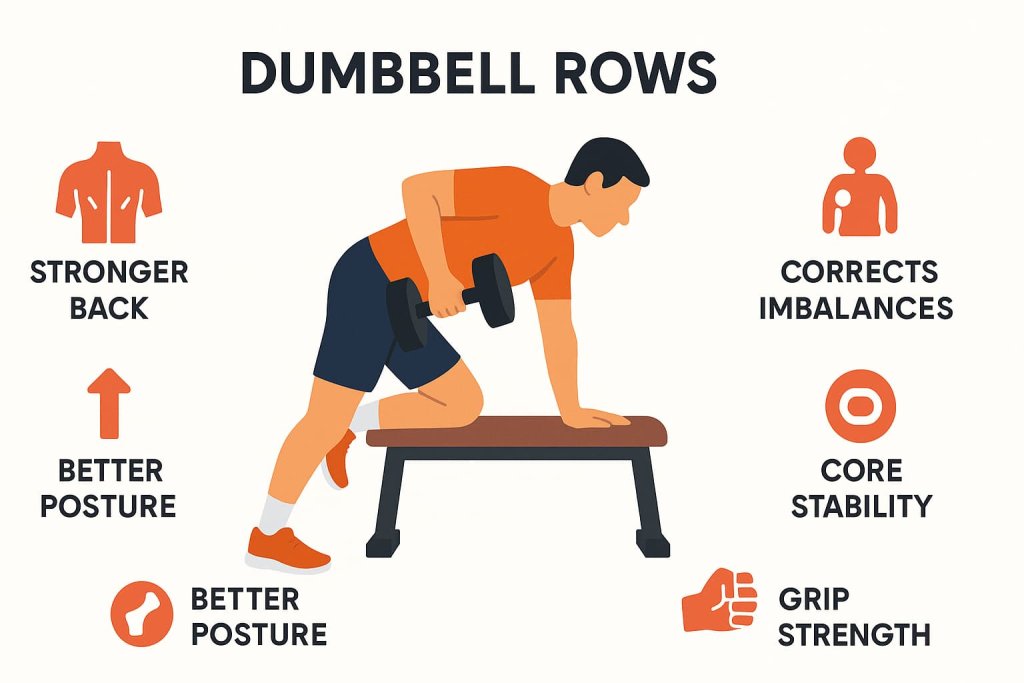The dumbbell row is one of the most effective exercises for building a stronger, wider back while improving posture and core stability. It targets multiple upper-body muscles at once, making it a staple for beginners and advanced lifters alike.

Knowing the correct form, variations, and common mistakes will help you get the most out of this movement and avoid injury. Whether you want to add muscle, fix imbalances, or simply improve your pulling strength, the dumbbell row offers scalable options for all fitness levels.
How to Do the Dumbbell Row with Proper Form
Single-Arm Dumbbell Row (Bench-Supported)
- Place your right knee and right hand on a flat bench, holding a dumbbell in your left hand.
- Keep your back straight, core engaged, and head in line with your spine.
- Pull the dumbbell toward your waist, squeezing your shoulder blade at the top.
- Lower it slowly until your arm is fully extended.
- Repeat for reps, then switch sides.
Pro Tip: Keep your torso still—avoid twisting or jerking the weight.
Bent-Over Two-Arm Dumbbell Row
- Stand with feet hip-width apart, holding a dumbbell in each hand.
- Hinge at the hips until your torso is nearly parallel to the floor.
- Pull both dumbbells toward your ribcage, elbows close to your sides.
- Lower slowly to the starting position.
- Repeat for reps.
Pro Tip: Maintain a neutral spine to avoid lower back strain.
Muscles Worked in the Dumbbell Row
The dumbbell row engages multiple muscle groups, making it a compound pull exercise:
- Primary Muscles:
- Latissimus dorsi (lats)
- Rhomboids
- Trapezius (middle and lower traps)
- Posterior deltoids
- Secondary Muscles:
- Biceps brachii
- Brachialis & brachioradialis (forearms)
- Core stabilizers (obliques, spinal erectors)
Benefits of Dumbbell Rows

- Builds a Stronger Back – Enhances pulling strength for sports and daily life.
- Improves Posture – Strengthens postural muscles to counteract slouching.
- Corrects Imbalances – Single-arm variations target each side independently.
- Enhances Core Stability – Requires core engagement to maintain position.
- Boosts Grip Strength – Holding heavy dumbbells challenges forearm endurance.
Common Mistakes to Avoid
| Mistake | Why It’s a Problem | How to Fix It |
|---|---|---|
| Using too much weight | Sacrifices form and increases injury risk | Start light, focus on controlled reps |
| Jerking or twisting | Reduces back activation and strains the spine | Keep core braced, pull in a smooth motion |
| Rounding the back | Increases lower back stress | Maintain a neutral spine throughout |
| Elbows flaring out | Reduces lat engagement | Keep elbows tucked close to your sides |
| Short range of motion | Limits muscle activation | Fully extend and retract each rep |
Variations of the Dumbbell Row
1. Incline Bench-Supported Row
Why It Works:
- Removes lower back strain, making it beginner-friendly and safe for those with back issues.
- Forces strict form and prevents momentum use, maximizing muscle engagement.
How to Do It:
- Set a bench to a 30–45° incline.
- Lie chest-down on the bench, holding a dumbbell in each hand with arms extended.
- Pull the dumbbells toward your ribcage, squeezing your shoulder blades together.
- Slowly lower the weights back to the start.
- Repeat for 8–12 reps.
Pro Tip: Keep your neck neutral and avoid shrugging your shoulders—focus on your lats and mid-back.
2. Kroc Row
Why It Works:
- Builds massive back thickness and grip strength due to heavy, high-rep sets.
- Allows a slight controlled torso sway to handle more load than a strict row.
How to Do It:
- Stand beside a bench, holding a heavy dumbbell in one hand.
- Place your opposite knee and hand on the bench for support.
- Row the dumbbell toward your waist with a powerful pull.
- Lower under control, allowing a slight twist if necessary.
- Perform 15–30 reps per arm.
Pro Tip: Use lifting straps for extremely heavy sets so grip fatigue doesn’t limit your back training.
3. Stability Ball Row
Why It Works:
- Engages your core and stabilizers more than a bench because of the unstable surface.
- Improves balance while targeting the lats, traps, and rhomboids.
How to Do It:
- Lie face down over a stability ball, feet planted wide for balance.
- Hold a dumbbell in each hand with arms extended toward the floor.
- Row both dumbbells toward your torso, squeezing at the top.
- Lower slowly and repeat for 10–15 reps.
Pro Tip: Start with light weights to master the balance before progressing.
4. Renegade Row
Why It Works:
- Trains the back while challenging core stability and anti-rotation strength.
- Works multiple muscle groups in a single, time-efficient move.
How to Do It:
- Get into a plank position, gripping hex dumbbells under your shoulders.
- Row one dumbbell toward your waist without twisting your hips.
- Lower it back down and switch sides.
- Alternate for 8–12 reps per side.
Pro Tip: Keep your feet wider apart for more stability until your core strength improves.
Alternatives to the Dumbbell Row
1. Barbell Row
Why It Works:
- Allows you to load more weight than dumbbells, boosting strength and size.
- Engages the lats, traps, rhomboids, and erector spinae in one powerful pull.
How to Do It:
- Stand with feet shoulder-width apart, holding a barbell with an overhand grip.
- Bend at the hips until your torso is at about 45°.
- Pull the bar toward your upper waist/lower chest.
- Lower slowly and repeat for 8–12 reps.
Pro Tip: Keep your core tight and spine neutral to protect your lower back.
2. Cable Seated Row
Why It Works:
- Provides constant tension throughout the movement.
- Easier to control and maintain good posture, great for beginners.
How to Do It:
- Sit at a cable row station with feet against the platform.
- Grab the handle with both hands and sit tall.
- Pull the handle toward your torso, squeezing shoulder blades together.
- Slowly return to the starting position.
Pro Tip: Avoid leaning back—keep the movement in your arms and back.
3. Inverted Row
Why It Works:
- Excellent bodyweight option that builds pulling strength and scapular control.
- Easily scalable for beginners and advanced lifters.
How to Do It:
- Lie under a bar set at waist height.
- Grab the bar with an overhand grip, hands shoulder-width apart.
- Keep your body straight and pull your chest to the bar.
- Lower with control.
Pro Tip: The lower the bar, the harder the exercise—adjust height to your level.
4. T-Bar Row
Why It Works:
- Combines machine stability with heavy free-weight loading.
- Targets mid-back thickness and trap development.
How to Do It:
- Stand over a T-bar row setup or landmine attachment.
- Grip the handles and hinge forward until your torso is just above parallel.
- Pull the handles toward your chest.
- Lower slowly and repeat for 8–12 reps.
Pro Tip: Use a close grip for more lats and a wide grip for more upper back and rear delts.
Who Should Do the Dumbbell Row?
- Beginners – Great for learning pulling mechanics with manageable weight.
- Intermediate & Advanced Lifters – Essential for back strength and hypertrophy.
- Athletes – Improves pulling power, grip, and posture for sports performance.
- People with Desk Jobs – Helps counteract rounded shoulders and forward head posture.
Trainer Tips for Maximum Results
- Warm up with light weight before heavy sets.
- Use a slow eccentric (lowering) phase for extra muscle engagement.
- Train 2–3 times per week for balanced back development.
- Pair rows with vertical pulls (like pull-ups) for complete back training.
Read Also: 8 Dumbbell Lat Exercises for a Wider, Stronger Back
Frequently Asked Questions (FAQ) About Dumbbell Rows
1. Are dumbbell rows better with one arm or two?
Both have benefits. Single-arm rows help correct imbalances and allow a greater range of motion, while two-arm rows save time and promote symmetrical strength.
2. How heavy should I go for dumbbell rows?
Choose a weight that allows you to complete 8–12 reps with proper form. If you can’t control the weight without jerking or twisting, it’s too heavy.
3. Can dumbbell rows hurt my lower back?
When performed with proper form and a neutral spine, dumbbell rows are safe. If you have a history of back pain, try a chest-supported variation.
4. How many sets and reps should I do?
For muscle growth, aim for 3–4 sets of 8–12 reps per side. For endurance, use lighter weight and perform 12–15 reps.
5. Should I do dumbbell rows on back day or pull day?
Yes — they fit perfectly in a back-focused workout or pull day as a horizontal pulling movement.
6. Are dumbbell rows good for posture?
Yes. Strengthening your upper and mid-back muscles helps counteract slouching and forward head posture.
7. Can beginners do dumbbell rows?
Absolutely. Start with a light weight, focus on form, and progress gradually.
Conclusion
The dumbbell row is a versatile, joint-friendly, and highly effective back exercise that belongs in every strength program. By mastering proper form, exploring variations, and avoiding common mistakes, you can build a stronger, healthier back and better posture.
Start adding dumbbell rows to your workouts now—and watch your pulling power soar.
